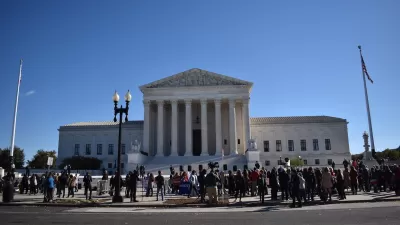The Supreme Court might decide on the constitutionality of inclusionary zoning. Local land use regulations and affordable housing policies in cities and communities all over the country hang in the balance.

Kriston Capps reports on the background and details of a court case expected to appear before the Supreme Court that amounts to whether inclusionary zoning is an unconstitutional government taking of private property.
The court case was born in Marin County, where two property owners, Dartmond and Esther Cherk, were forced to either include affordable housing or pay an in-lieu fee when trying to develop a residential parcel into two single-family-zoned lots.
Capps explains the stakes of a possible Supreme Court hearing for Dartmond Cherk, et al. v. Marin County, California.
The Marin County case may test the constitutionality of inclusionary zoning, a tool that local jurisdictions rely on to expand the supply of affordable housing, especially in tight housing markets. The court has expressed an interest in the case, which the justices may wind up using as a wedge to reshape property rights. It’s possible the inclusionary zoning ordinances—and local regulations more broadly construed—will not stand under the court’s scrutiny.
Capps explains the status of the case relative to the Supreme Court's interest in deciding the matter. "Housing advocates and industry associations are filing briefs on both sides of the case," according to Capps, and "the court asked Marin County for its response, which attorneys must file by October 7."
The Supreme Court's position on whether inclusionary zoning amounts to an unconstitutional taking could also have implications for land use regulations that have environmental outcomes in mind, according to Capps.
FULL STORY: Will the Supreme Court Strike Down Inclusionary Zoning?

Alabama: Trump Terminates Settlements for Black Communities Harmed By Raw Sewage
Trump deemed the landmark civil rights agreement “illegal DEI and environmental justice policy.”

Planetizen Federal Action Tracker
A weekly monitor of how Trump’s orders and actions are impacting planners and planning in America.

The 120 Year Old Tiny Home Villages That Sheltered San Francisco’s Earthquake Refugees
More than a century ago, San Francisco mobilized to house thousands of residents displaced by the 1906 earthquake. Could their strategy offer a model for the present?

In Both Crashes and Crime, Public Transportation is Far Safer than Driving
Contrary to popular assumptions, public transportation has far lower crash and crime rates than automobile travel. For safer communities, improve and encourage transit travel.

Report: Zoning Reforms Should Complement Nashville’s Ambitious Transit Plan
Without reform, restrictive zoning codes will limit the impact of the city’s planned transit expansion and could exclude some of the residents who depend on transit the most.

Judge Orders Release of Frozen IRA, IIJA Funding
The decision is a victory for environmental groups who charged that freezing funds for critical infrastructure and disaster response programs caused “real and irreparable harm” to communities.
Urban Design for Planners 1: Software Tools
This six-course series explores essential urban design concepts using open source software and equips planners with the tools they need to participate fully in the urban design process.
Planning for Universal Design
Learn the tools for implementing Universal Design in planning regulations.
Clanton & Associates, Inc.
Jessamine County Fiscal Court
Institute for Housing and Urban Development Studies (IHS)
City of Grandview
Harvard GSD Executive Education
Toledo-Lucas County Plan Commissions
Salt Lake City
NYU Wagner Graduate School of Public Service





























